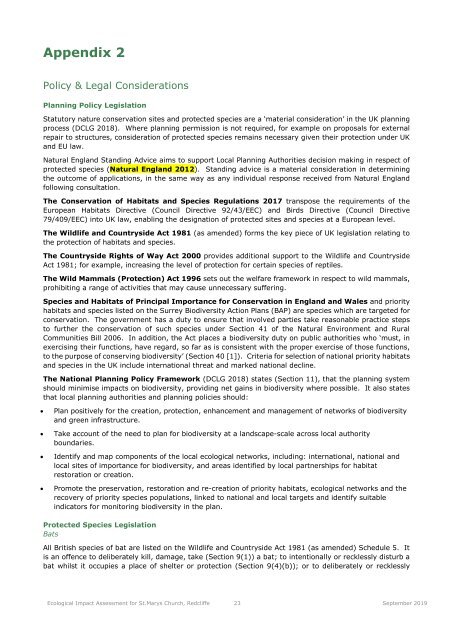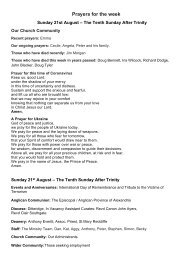St Mary Redcliffe Ecological Impact Assessment
Create successful ePaper yourself
Turn your PDF publications into a flip-book with our unique Google optimized e-Paper software.
Appendix 2<br />
Policy & Legal Considerations<br />
Planning Policy Legislation<br />
<strong>St</strong>atutory nature conservation sites and protected species are a ‘material consideration’ in the UK planning<br />
process (DCLG 2018). Where planning permission is not required, for example on proposals for external<br />
repair to structures, consideration of protected species remains necessary given their protection under UK<br />
and EU law.<br />
Natural England <strong>St</strong>anding Advice aims to support Local Planning Authorities decision making in respect of<br />
protected species (Natural England 2012). <strong>St</strong>anding advice is a material consideration in determining<br />
the outcome of applications, in the same way as any individual response received from Natural England<br />
following consultation.<br />
The Conservation of Habitats and Species Regulations 2017 transpose the requirements of the<br />
European Habitats Directive (Council Directive 92/43/EEC) and Birds Directive (Council Directive<br />
79/409/EEC) into UK law, enabling the designation of protected sites and species at a European level.<br />
The Wildlife and Countryside Act 1981 (as amended) forms the key piece of UK legislation relating to<br />
the protection of habitats and species.<br />
The Countryside Rights of Way Act 2000 provides additional support to the Wildlife and Countryside<br />
Act 1981; for example, increasing the level of protection for certain species of reptiles.<br />
The Wild Mammals (Protection) Act 1996 sets out the welfare framework in respect to wild mammals,<br />
prohibiting a range of activities that may cause unnecessary suffering.<br />
Species and Habitats of Principal Importance for Conservation in England and Wales and priority<br />
habitats and species listed on the Surrey Biodiversity Action Plans (BAP) are species which are targeted for<br />
conservation. The government has a duty to ensure that involved parties take reasonable practice steps<br />
to further the conservation of such species under Section 41 of the Natural Environment and Rural<br />
Communities Bill 2006. In addition, the Act places a biodiversity duty on public authorities who ‘must, in<br />
exercising their functions, have regard, so far as is consistent with the proper exercise of those functions,<br />
to the purpose of conserving biodiversity’ (Section 40 [1]). Criteria for selection of national priority habitats<br />
and species in the UK include international threat and marked national decline.<br />
The National Planning Policy Framework (DCLG 2018) states (Section 11), that the planning system<br />
should minimise impacts on biodiversity, providing net gains in biodiversity where possible. It also states<br />
that local planning authorities and planning policies should:<br />
• Plan positively for the creation, protection, enhancement and management of networks of biodiversity<br />
and green infrastructure.<br />
• Take account of the need to plan for biodiversity at a landscape-scale across local authority<br />
boundaries.<br />
• Identify and map components of the local ecological networks, including: international, national and<br />
local sites of importance for biodiversity, and areas identified by local partnerships for habitat<br />
restoration or creation.<br />
• Promote the preservation, restoration and re-creation of priority habitats, ecological networks and the<br />
recovery of priority species populations, linked to national and local targets and identify suitable<br />
indicators for monitoring biodiversity in the plan.<br />
Protected Species Legislation<br />
Bats<br />
All British species of bat are listed on the Wildlife and Countryside Act 1981 (as amended) Schedule 5. It<br />
is an offence to deliberately kill, damage, take (Section 9(1)) a bat; to intentionally or recklessly disturb a<br />
bat whilst it occupies a place of shelter or protection (Section 9(4)(b)); or to deliberately or recklessly<br />
<strong>Ecological</strong> <strong>Impact</strong> <strong>Assessment</strong> for <strong>St</strong>.<strong>Mary</strong>s Church, <strong>Redcliffe</strong> 23 September 2019


















